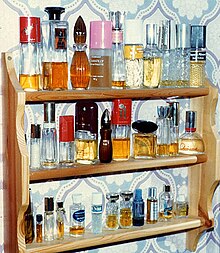Our website is made possible by displaying online advertisements to our visitors.
Please consider supporting us by disabling your ad blocker.
Aroma compound

An aroma compound, also known as an odorant, aroma, fragrance or flavoring, is a chemical compound that has a smell or odor. For an individual chemical or class of chemical compounds to impart a smell or fragrance, it must be sufficiently volatile for transmission via the air to the olfactory system in the upper part of the nose. As examples, various fragrant fruits have diverse aroma compounds,[1] particularly strawberries which are commercially cultivated to have appealing aromas, and contain several hundred aroma compounds.[1][2]
Generally, molecules meeting this specification have molecular weights of less than 310.[3] Flavors affect both the sense of taste and smell, whereas fragrances affect only smell. Flavors tend to be naturally occurring, and the term fragrances may also apply to synthetic compounds, such as those used in cosmetics.[4]
Aroma compounds can naturally be found in various foods, such as fruits and their peels, wine, spices, floral scent, perfumes, fragrance oils, and essential oils. For example, many form biochemically during the ripening of fruits and other crops.[1][5] Wines have more than 100 aromas that form as byproducts of fermentation.[6] Also, many of the aroma compounds play a significant role in the production of compounds used in the food service industry to flavor, improve, and generally increase the appeal of their products.[1]
An odorizer may add a detectable odor to a dangerous odorless substance, like propane, natural gas, or hydrogen, as a safety measure.
- ^ a b c d El Hadi, Muna; Zhang, Feng-Jie; Wu, Fei-Fei; Zhou, Chun-Hua; Tao, Jun (July 11, 2013). "Advances in fruit aroma volatile research". Molecules. 18 (7): 8200–8229. doi:10.3390/molecules18078200. ISSN 1420-3049. PMC 6270112. PMID 23852166.
- ^ Ulrich, Detlef; Kecke, Steffen; Olbricht, Klaus (March 13, 2018). "What do we know about the chemistry of strawberry aroma?". Journal of Agricultural and Food Chemistry. 66 (13): 3291–3301. doi:10.1021/acs.jafc.8b01115. ISSN 0021-8561. PMID 29533612.
- ^ Rothe, M; Specht, M (1976). "[Notes about molecular weights of aroma compounds]". Nahrung. 20 (3): 281–6. doi:10.1002/food.19760200308. PMID 958345. Retrieved September 29, 2020.
- ^ Fahlbusch, Karl-Georg; Hammerschmidt, Franz-Josef; Panten, Johannes; Pickenhagen, Wilhelm; Schatkowski, Dietmar; Bauer, Kurt; Garbe, Dorothea; Surburg, Horst. "Flavors and fragrances". Ullmann's Encyclopedia of Industrial Chemistry. Weinheim: Wiley-VCH. doi:10.1002/14356007.a11_141. ISBN 978-3527306732.
- ^ Haugeneder, Annika; Trinkl, Johanna; Härtl, Katja; Hoffmann, Thomas; Allwood, James William; Schwab, Wilfried (October 26, 2018). "Answering biological questions by analysis of the strawberry metabolome". Metabolomics. 14 (11): 145. doi:10.1007/s11306-018-1441-x. ISSN 1573-3882. PMC 6394451. PMID 30830391.
- ^ Ilc, Tina; Werck-Reichhart, Danièle; Navrot, Nicolas (September 30, 2016). "Meta-analysis of the core aroma components of grape and wine aroma". Frontiers in Plant Science. 7: 1472. doi:10.3389/fpls.2016.01472. ISSN 1664-462X. PMC 5042961. PMID 27746799.
Previous Page Next Page


